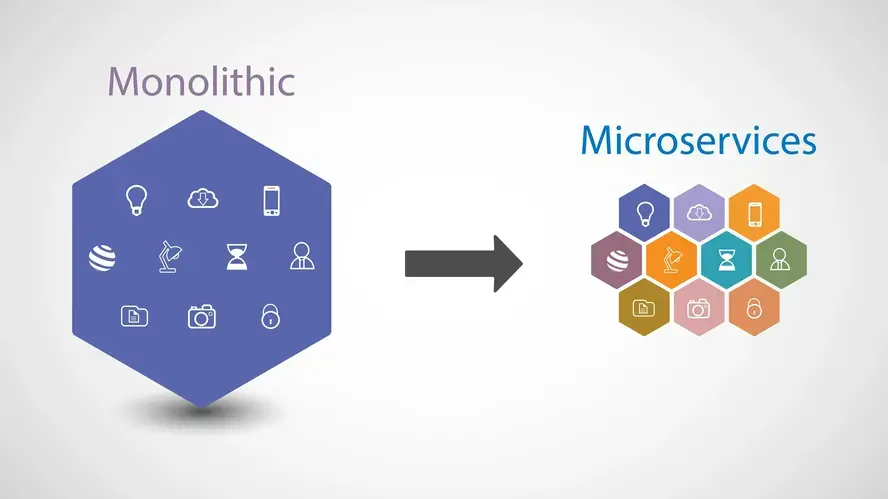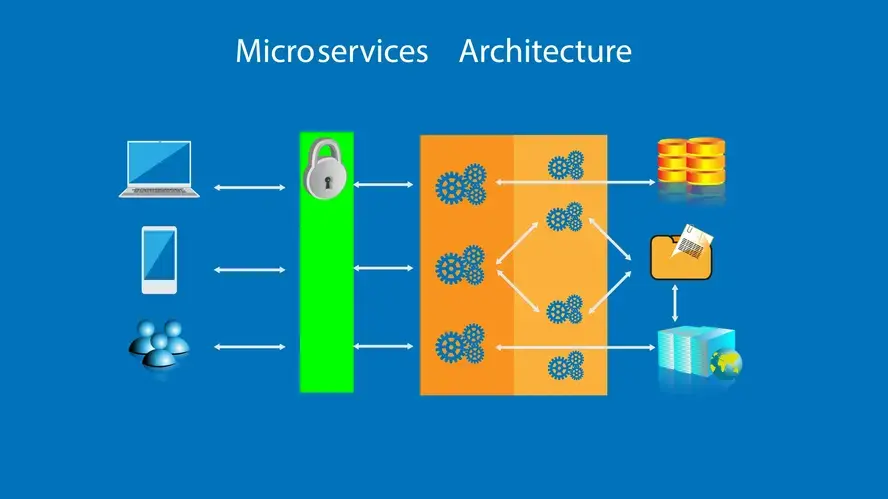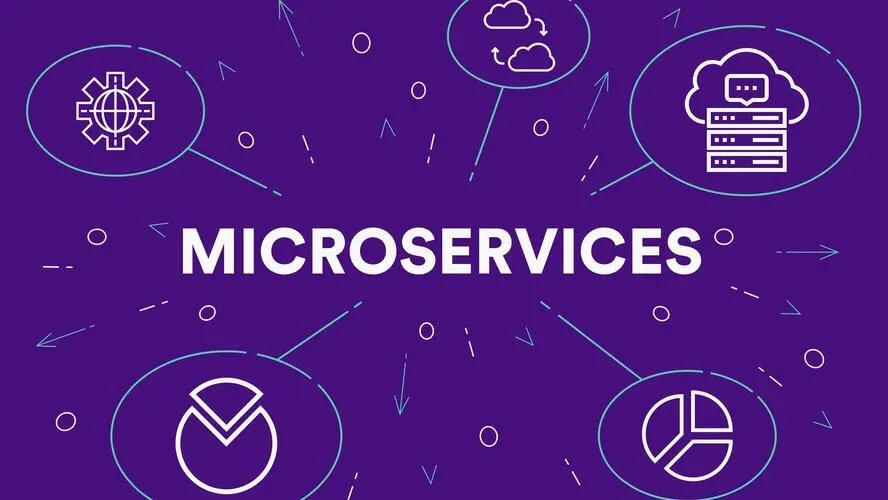Take a guess at the trend advancing to the borders of all tech-ware interfaces. No, it's not Facebook's "metaverse" or Google's “AI generators," but rather, the recent trend in the web development industry is microservices. Wait — before you dismiss the concept entirely or dismiss it as a fad, you should be aware that projects with use cases for these microservices have had some success with it. These early results have prompted other businesses to follow suit, leading to the surge in popularity we are seeing now.
What is Microservices Architecture about?
Microservices have their origins in the distributed systems of the 1980s and 1990s, which sought to improve the flexibility and scalability of software applications by breaking them down into smaller, independent components that could be developed and deployed independently.
The term "microservices," on the other hand, was not coined until around 2011, when it was used to describe a specific approach to designing and building distributed systems, despite the fact that it has been around since the early 2000s. Is that to say you should stop what you're doing and jump on the bandwagon? Not exactly.
The architecture of your application is not something you should take lightly. We will help you by outlining what microservices are, going over their advantages and disadvantages, and then offering a few tools to make creating microservices efficient. This will allow you to decide whether microservices are right for you.
What are Microservices?
According to Martin Fowler, Chief Scientist of ThoughtWorks, “Microservice architecture is an approach to developing a single application as a suite of small services, each running in its own process and communicating with lightweight mechanisms, often an HTTP resource API”.
Microservices are a style of software system that is quickly becoming commonplace in the overly sceptical world of software architecture. It is a software architectural style in which an application is structured as a collection of small, independent services rather than a monolithic whole. These services are designed to be loosely coupled, which means they can be developed, tested, and deployed separately.
A microservice handles a dedicated function inside a large-scale application. In an eCommerce site, for instance, the sections dedicated to user profiles, shopping carts, and billing can be separate Microservices.
Monolith Architecture vs Microservice Architecture

Before microservices, there was Monolithic Architecture, which was the industry's standard software architectural style.
A monolithic architecture is a method of software design in which a single, unified application is built as a single unit.
This means that all of the application's components, including the user interface, business logic, and data storage, are built and deployed as a single package.
Microservice architecture, on the other hand, is a software design approach in which a large application is built as a collection of small, independent services. Each microservice is a self-contained unit that handles a single task or function. As the services are loosely coupled, they can be developed, tested, and deployed independently. Suppose there are three services in an application, one for the users' account, one for the shopping cart, and one for pricing/shipping. Each service will have its own database and API. The API gateway accepts requests from the device in use and routes them to the APIs of the different services.
There are several significant distinctions between monolithic and microservice architectures:
Price
Monolithic: Cost Increases once the project scales.
Microservice: High cost at the first stage of development.
Coding
Monolithic: One codebase and database for the entire application.
Microservice: Multiple code files; different components can be written in different languages.
Deployment
Monolithic: The features of the software are wrapped in a single code base, this means that the entire code base needs to be deployed en masse.
Microservice: The components of microservice are tested and deployed individually.
Moving from a monolithic approach to microservices is due to several challenges; an example would be addressing the issue of debugging and applying quick updates. The code base in monolithic architecture is large, which makes it difficult for developers to contribute to it, and this causes inefficiency.
In a microservices architecture, each service performs a specific business function and communicates with other services via well-defined interfaces, typically based on lightweight protocols such as HTTP and REST API.
In contrast to traditional development processes, this approach allows teams to work on individual services in parallel and deploy them independently of one another, resulting in greater flexibility and agility. Furthermore, it facilitates scalability since individual services can be scaled up or down without affecting the overall system, and it encourages the use of different technologies, and the use of different languages for development.
Advantages and Disadvantages of Microservices
Advantages
Disadvantages
Advantages of Microservices
Decomposing an application into microservices involves breaking it down, which has several advantages, including:
Easy Deployment
Microservices are loosely coupled which allows fast and easy deployment of individual features.
Scaling
Microservices scale services when needed instead of the whole application. You can manage different updates i.e. add, remove, etc without interrupting another microservice in the application.
Debugging and Maintenance
Debugging and maintenance are simplified because of smaller functional services.
Reusable Code
In a microservice architecture, developers can write code once and use it several times at different periods in the application.
Freedom of Approach
The microservice approach is very open-ended which means that developers are able to explore and select the best tools that work best for their projects.
Disadvantages of Microservices
Here are a few challenges that occur when microservices are adapted;
Complex Implementation
Implementation is complex because of its distributed system nature which is as much an advantage as it is a disadvantage.
Security Risk
There are multiple moving parts involved in microservices, which makes them prone to security issues. Securing the application must be crucial to avoid malicious attacks.
Technology Diversity
Because developers can work with different languages and technologies in one application is also a disadvantage. This diverse and flexible structure can become hard to maintain.
Why you should consider Microservice architecture

Here are three (4) fundamental reasons why you should implement a Microservice architecture.
If your business system is composed of several large-scale moving parts and large teams. In the case a function or domain can be maintained independently by a designated team this enables team independence.
If your business is built on outdated systems.
When the application requires multiple resources and expects high traffic.
If your business relies on homogeneous systems that use the same technology for every aspect of deployment.
Testing different processes with microservices allow you to choose the right technology for specific service deployments. Popular companies like Netflix, Amazon, Walmart, and Spotify have all successfully used microservices architecture; here’s how it went:
Netflix
In 2012, Netflix restructured from a monolithic service to microservices, and by 2017 the architecture had over 700 loosely coupled microservices. They were able to address certain issues with service outages and scaling. This move reduced their cloud cost significantly.
Amazon
Amazon adapted microservices to address issues regarding scalability. The e-commerce site was built on a single application, which was complex, difficult to maintain, and scale; the company now manages its e-commerce company with hundreds of microservices.
Security Challenges and Solutions for Microservices Architecture
There are many services in a single application and this comes with its set of challenges, here are some security challenges microservices face;
Increased attack surface
Different services are run on different ports, exposing these ports and APIs, and causing a security vulnerability. In this case, microservices must be secured tightly to prevent malicious attacks.
Isolation Failure
This can occur when one microservice fails to communicate with another microservice. This causes security concerns in microservice architecture because it can result in access to sensitive data or the failure of vital functions. Implementing robust security measures such as communication protocols, encryption, and firewalls reduces the risk of isolation failure. Regular testing and monitoring of applications also prevent system failure.
DevOps
When an application is being released or tested, security vulnerabilities are likely to occur. DevOps must be able to identify, evaluate, and manage risk. Also, DevOps must work closely together to ensure the success of a microservice architecture.
Fault tolerance
The capacity of an application to continue operating when it develops a bug or if one or more of its components stop working is what we call fault tolerance. The likelihood of failure increases when a large number of services are interacting over a network. This means that in order to prevent interruptions to your entire application, the server must be able to handle service failure. Failures in microservices can be handled by fallback measures like a circuit breaker.
Best Practices to Build Secure, Scalable Microservices
Data and API Security
Due to the communication between services, there must be tight security to prevent exploitation. Security certificates must be maintained, and data must be encrypted. Access to APIs must be scrutinised, therefore, only authorised users must have access to them.
In-Depth Defence
Defence-in-depth is a way of protecting microservices. By incorporating several layers of security control into an application, you can protect critical services. If an attacker gains access to one component of an application, additional security measures may prevent the attacker from attempting to exploit other components.
API Gateway
API gateway is in charge of directing traffic or routing incoming requests to the relevant Microservices. The API gateway is secured using token-based authentication. It is advisable to add a layer of protection around the attack surface by placing it behind a firewall to prevent exploitation.
Microservices Tools
There are several tools for building a microservice application.
Tools for API management and testing e.g API fortress and Postman, etc.
Messaging e.g Apache Kafta
Monitoring e.g Logstash, Graylog, etc.
Programming languages e.g spring boot, elixir, etc.
Toolkits e.g fabric 8, serverless tools e.g serverless, Claudia, etc. just to mention a few.
Conclusion
Distributed systems are complex, and they have their pros and cons. From the standpoint of microservices, we can separate the various parts of an application into smaller, independent teams that concentrate on smaller codebases. This method makes it simpler to manage the application, address bugs, and effectively add new features.
After understanding what microservices are, we'll discuss how to create them using a variety of tools, some of which are mentioned above, in later articles.
If you're looking for a reliable and affordable web hosting plan, then you're in luck! We have a wide variety of hosting options for you to choose from, and our prices are competitive. So why not check out our plans today and find the one that works best for you?
Frequently Asked Questions
Do I need web developer skills to use Shopify or WooCommerce?
No. Both platforms welcome beginners, but you might get more out of WooCommerce’s extensions if you’ve got some previous experience.
Can WordPress be used for eCommerce?
WordPress offers many different ways to build an eCommerce online store for all types of products and markets. Almost 40 percent of all online shops are powered by WooCommerce, a WordPress eCommerce plugin.
Can I migrate a WordPress site to Drupal?
Yes. There are also modules that can help you with migrating a website from WordPress to Drupal.
Can I use hosting for WordPress for an ecommerce site?
Yes, of course. In fact, the platform has some of the best online stores and a range of payment processor plugins on the market.

Jessica Agorye is a developer based in Lagos, Nigeria. A witty creative with a love for life, she is dedicated to sharing insights and inspiring others through her writing. With over 5 years of writing experience, she believes that content is king.
View all posts by Jessica Agorye



















